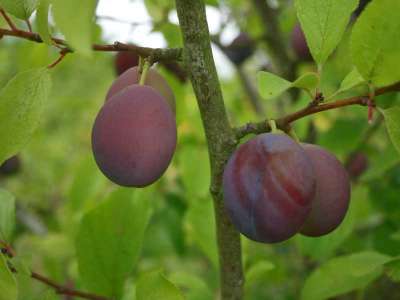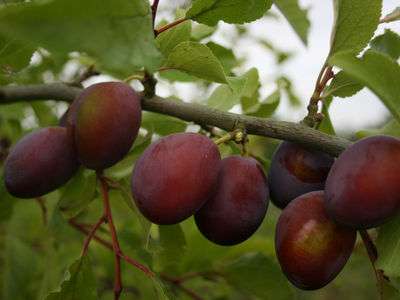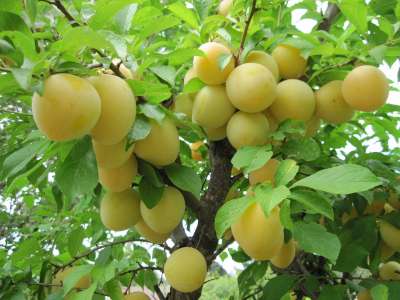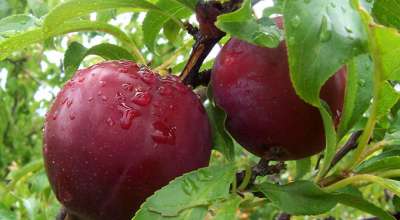Your basket is currently empty!
Click here to buy quality Victoria Plum Trees
Victoria plum trees are available for sale year round.
How to grow Victoria Plum trees – in a nutshell……
- For a dwarf Plum Tree – Pixy is a dwarf bush rootstock, space required approx 7′ wide and 8′ high, smaller when containerized.
- ‘St Julien‘ makes a bigger orchard sized tree for grassy area etc, needing 10’ across, 12’+ high
- A supercolumn tree is a narrow space saving option for border, pots, etc, just 18″ across, 6-7′ high
- Victoria grows against any sunny warm wall as a fan, space required 6-8′ high & wide
- Victoria is self fertile so doesn’t need another Plum to crop
- Plant bare root October-April, or from pot-grown at other times
- Most well drained ordinary soils are suitable, in a sunny spot
- Smaller dwarfing trees can crop 1-2 years after planting, more vigorous stocks take longer – 3-4 years sometimes.
The divinely flavoured Victoria Plum is quite likely the most famous fruit tree ever raised, certainly for garden growing. Ask anyone to name a Plum tree and it will almost inevitably be a Victoria, brought to mind by that divinely sweet and succulent flavour and the distinctive rosy red over yellow flush. For over a century it has inspired devotion and love amongst gardeners, orchardists and foodies alike.
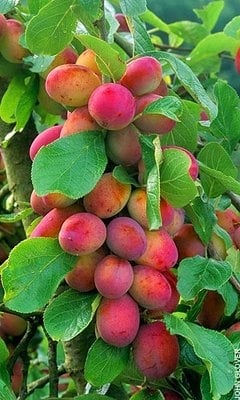
As a garden tree it has it’s advantages – and it’s disadvantages. It’s by no means a ‘prefect’ variety to grow but with some thought and planning it’s easy for anyone – no matter what gardening resources of knowledge you have – to grow a Victoria plum successfully. This article will take you through all the steps required to make the choice perfect for your garden.
Soil Conditions
First, make sure you have good soil. Plum trees can be fairly tolerant but the better the conditions to start with then the better the results will be. Ideally the soil should not have grown plum trees before. The soil should be fairly friable and well worked – dig it over 2 or 3 times, an area about 24 x 24” is sufficient and about 18” deep This gives you room to add some fertilizer to the mix – growmore is fine – and also some organic rich matter if you have any. Contents from a compost heap, or some ready-bought compost will be ideal. Make sure the soil is well drained – no Plum likes poor drainage in the winter – and choose a nice sunny spot to ripen those fruits to perfection in the Summertime.
Siting
Choose the sunniest spot you have and preferably sheltered too. Plum trees are hardy enough of course, but late frosts can spoil the flowers and reduce the yield, and strong winds too can dislodge burgeoning fruits before they are ready & even snap branchesd if they are heavy with fruit.
Choice of growing methods
There are actually several different ways in which you can grow a Victoria plum – surely something to suit everyone. Varying methods and tree shapes suit different applications.
Plum trees for small gardens
Choose the Pixy stock as mentioned before and grow as a small bush tree, or try the ‘column’ method, this fits very easilt into a garden border or container and casts little shade.
The Bush Tree
The most popular and recognizable – a ‘tree’ shaped tree that is sub divided into two forms – the vigorously growing tree and the dwarf tree.
Let’s start with a dwarf tree. A nice easy to manage smallish tree which can be kept to a minimum of 7-8’ – remember the spread of the tree will be the same as it’s height. To grow a dwarf Victoria plum tree you need to ensure the tree you buy in on Pixy stock. This ensures nice compact growth. A Victoria plum tree on the Pixy stock is ideal for smaller garden lawn or a border. It should be grown free standing and you can then grass beneath it, or even grow herbs, salads or smaller flowering plants. With this stock you can harvest all the fruits from the ground, no ladders required!
A more vigorously growing tree is known as St Julien stock. It’s more of a traditional tree that is used more often in orchards or the larger lawn. Crops are amongst the heaviest of all and it makes a grand tree to sit under too! It’s easy to grow and will reach 12’ or more – with a similar spread. So it’s not a tree for small areas but where there’s room it’s the best choice for productivity and ease of growth. You will need a ladder to pick all the fruits from a full grown tree ‘though.
Other even bigger stocks are available – such as the old ‘Brompton’ stock which is still to be found in very old orchards today. It makes a really big traditional tree, much too large for the average garden but still useful for big areas. It will reach 20’ or more – that’s a lot of Plum tree!
Growing Against a Wall
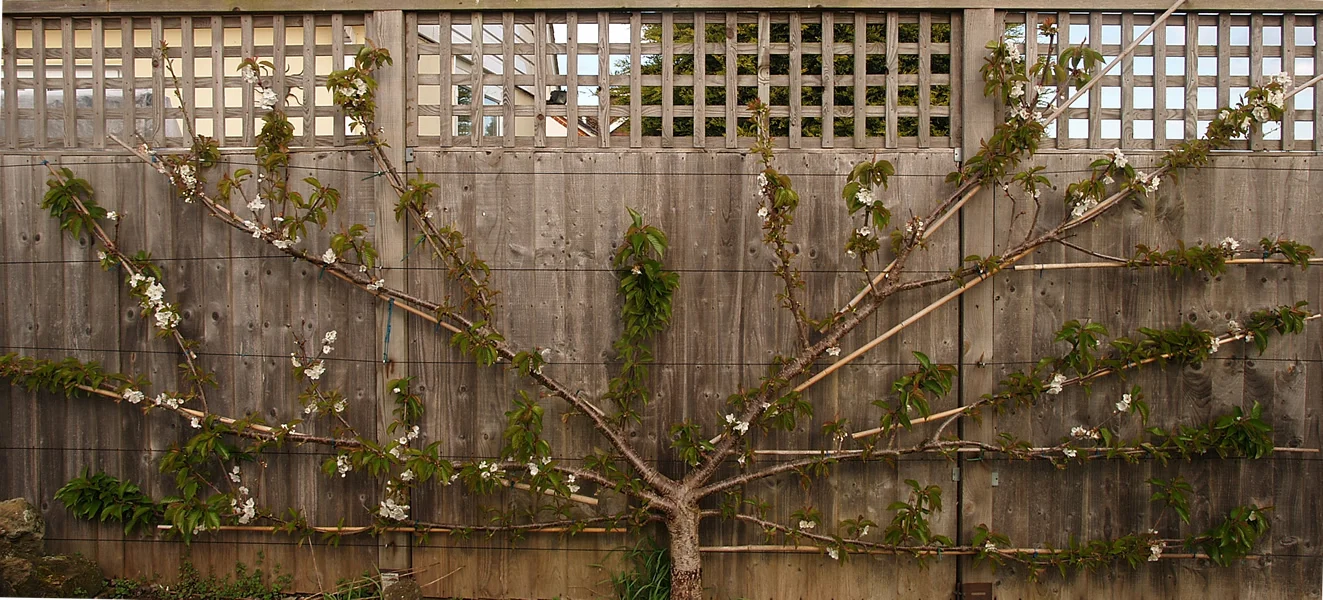
Fan training is a lovely way of growing Victoria plums if you have a nice South or west facing wall. It won’t do well on an East or North aspect because the fruit likes a lot of sun to ripen – under these conditions you get supremely sweet and flavoursome fruits and the tree crops well with the added protection from late frosts. You will need to fix 3 straining wires – rubber or plastic coated – one at about 18” and two more at 24” intervals, on which to tie the branches of your new tree.
You will need a space of not less than 7-8’ wide to fan train your Victoria plum, and about the same height. When buying your tree make sure you select one that is specifically described as being suitable to train, or tell the nursery what you are doing with it so that a tree suited to the purpose is provided. You can’t start with a normal bush tree because the lower branches you want will already have been removed.
It’s quite easy to fan train a Victoria – or any plum. A young tree is best to start with – cut the whole thing back in the winter to about 18” so you’re left with an umpromising stubby stick. From just below where you cut it off, later in the Spring, the two top-most buds will produce 2 strong new lateral branches. Tie them down horizontally to your supporting wires and remove anything else that forms during the summer. Those two branches will, most likely the next year, produce strong upright growths – and there you already have the makings of a ‘fan’ shape. You can then maintain the basic form from then on and remove any subsequent growth you don’t want, tying in that which you do.
Sometimes you can buy ready-fan trained trees but it’s better to train yourself in situ so the tree is adapted to it’s environment, it will look more natural. And it’s a lot cheaper too!
Column Victoria Plums
Quite a recent ‘invention’ is the narrow column style of tree that has been adapted for many different types of fruit variety. It suits Victoria plums perfectly. It’s the easiest method to prune and takes up the smallest amount of space by far so if you are short on space then this is the ideal option. You need just 24” to grow a column Plum tree. It also suits a container so really you’ve no excuse not to grow one! Who hasn’t got 24” in their plot somewhere, if the desire is there?
The only pruning necessary for column trees is to trim back all the side growths to about 6” in late Summer – that’s really it. The main central shoot at the top [called the ‘leader] can be reduced in length each season if you want to, but you don’t have to. In this way you can keep the height to about 6-8’ maximum.
A Stepover Tree
This is a useful little tree to grow as a border edging because it only grows to 15-18” height. It spreads about 5’ by way of just two lateral branches – imagine a tree in the shape of a capital ‘T’ and that’s a stepover tree. It has in the past more normally been associated with apples and pears, but a Victoria Plum works fine in this way as well. Plant 5’ apart.
Growing Plum trees in containers
I would reckon about 50% of our sales of Victoria plum tree come from gardeners who want to container grow their tree. It’s perfectly feasible – just make sure you choose the Pixy stock described earlier in this article, it’s a nice compact tree that will adapt well to a pot. Or you can choose the column option instead which makes a nice symmetrical tree for a pot.
The Size of Container
Is of paramount importance; it needs to be big enough to take a well developed root-system but, oddly, very large containers can be as ill-suited as too-small ones. If too large the unused compost goes stale and stagnant. Anything between 24-30” is fine for a dwarf Plum tree like Victoria.
The planting medium should be a proprietary good quality potting compost or, preferred, a loam based compost.
The choice of tree is also vitally important because you won’t want to try and contain a vigorously growing tree in a container. The tree should always be on ‘Pixy’ stock, whether it is a bush, or a column type tree.
Regular watering is key to success. Little and often – try to water every day if possible, or give a good soaking every other day. Adequate irrigation will be necessary during the growing season, which is from April to September, the key periods for watering being when growth is most active, from May to July. Before and after this you will find the compost does not dry out quite so quickly and tree won’t be using so much. Especially when the nights are colder – in Spring and Autumn – it doesn’t lose moisture nearly so quickly. Watering during the Winter is largely unnecessary – because the tree isn’t using any water and because with the more reliable rain and the bare branches of the tree the compost should get a good regular soaking anyway. The only exception to this is the pot is in a very sheltered position, in a corner by a wall perhaps, somewhere that tends to escape rain falling, in which case keep an eye on it and give some water if it appears dry.
Remember the tree is relying on you totally for it’s needs as it is contained. Additional feed will ned to be given monthly if you are using a foliar feed, or quarterly for most granular fertilizers.
Further Cultivation Notes
Harvesting – the Victoria plum season
To savour the fruits at their absolute best it is essential to harvest at the optimum time. It can be tempting to pluck them from the tree too soon and sometimes they colour up and appear ripe when they actually aren’t. Two rules to follow – the fruit should have a little ‘give’ when gently felt. Secondly it should part readily from the tree without too much of a struggle. And the fist falling fruits from the boughs is also an indication of ripeness. You can seldom harvest all the fruit at the same time because it won’t all ripen at the same time! The fruit ripens in flushes, so be prepared to go over the tree two or three times at least.
Victoria’s natural season is late August and early September so that’s a good indication of when to pick – but an indication is all it can be since this can vary widely from one season to the next – depending on the whether – but also according to locality, local growing conditions and the manner in which the tree has been cultivated. A tree growing on a nice warm wall for example will inevitably be earlier than a traditional tree in an open position.
Pollination for Victoria Plums
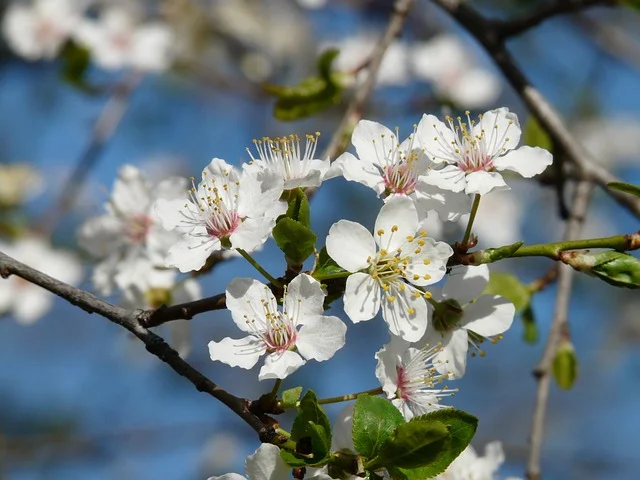
Many Plum trees need partner varieties to fruit well but Victoria is self-compatible so you do not need other trees nearby to ensure a good crop. Which brings us to the benefits of…..
Thinning
One of Victoria’s faults is it’s boom or bust philosophy to cropping. One year the boughs are weighted down with the abundance of crop and the next there’s nothing. Biennial cropping as it’s known is inherent in this variety. So, a year when a lot of fruit has been set requires some attention if you’re to avoid a fruiting drought the next. When the developing fruits are pea sized or a little more, go over the tree and remove by hand up to a quarter of them. The remaining fruits will be bigger and the tree will be much more likely to fruit properly the next season as a result. Try to be strong willed about this, it’s tempting to be lazy, or greedy, or both.
Victoria Plum tree problems and diseases
Victoria may suffer from the common Plum diseases just like any other. Silverleaf it is particularly prone to. The branches silver and die back; cut branches reveal a red inner ring which is typical of this disease which is relatively seldom seen – you would be unlucky to get it – but it is usually fatal. Trees with silverleaf are usually cut down and burned. Don’t confuse with common mildew – this fungal disease also manifests itself as silvered leaves but is treatable with a good broad spectrum fungicide.
By far the most common problem to afflict Plums is aphid and greenfly. You will soon notice these tiny insects as all the new shoots on your plum tree become curled and distorted, and may become streaked and yellowish. Relatively easy to combat with many proprietary insecticides available from a local outlet. If noticed early enough you can rub them off by hand [wear rubber gloves if you’re squeamish!!] Aphid and greenfly damage is usually the most noticeable in late Spring and early summer when the growth is at it’s most lush.
Grubs in Your Plums!
Nothing is more annoying than cutting into a seemingly perfect plum only to find a grub or maggot lurking inside! This is the larvae of Plum moth, a small insect that lays it’s eggs at the base of the pollinated flowers or embryonic fruits. The egg hatches and the tiny larve burrow into the fruit, the tiny hole soon disappears so there’s nothing to tell it is living inside merrily chomping away.
Pheromone traps can be effective against the moths, hang them on the tree in early Spring, at blossom time.
Frost Damage to Blossom
Many Plum trees full of blossom fail to yield, or yield poorly, when the period during flowering is frosty. This often happens, because flowering takes place quite early, late March sometimes even, or April. If your tree is a small one it’s worth considering draping some fleece or material over the tree during cold nights, to protect the flowers from frost damage. Be sure to remove the protective cover during the day time.
Pruning Victoria Plums
Strong growing young trees should have new upright growths cut back by one third in late summer. Growth that is lower down the main trunk should be removed clean at it’s base at the same time. Older trees should have dead or disease wood cut out whilst dormant and can be rejuvenated by selective harder pruning to promote new growth. Column trees may have the side laterals cut back to 2-3 bleaves in late summer, the leader may be cut back at this time also.
The Best plums to grow in the UK ….
Aside from Vcitoria which is a quintessential English variety, we really like Jubilee, Violetta, Czar, Marjories Seedling and Excaliber. Why not try Czar or Marjories Seedling to fruit early and later than the Victoria; you will then get a good spread season of fruits for many weeks.



